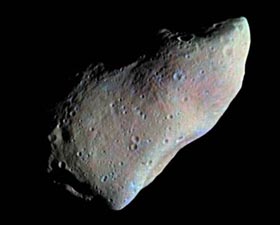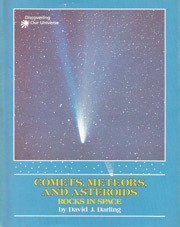COMETS, METEORS, AND ASTEROIDS: 4. Asteroids, the Hurtling Mountains

The asteroid Gaspra, which is about 12 miles (19 km) long. This picture was taken by the Galileo spacecraft when it flew past Gaspra in 1991.
Among the largest of space rocks are the asteroids. Most of these lie in a great belt – the ASTEROID BELT – that encircles the Sun between the orbits of Mars and Jupiter.
Scientists used to think that the asteroids were the pieces of a planet that broke up long ago. But today, we know that they could never have formed a planet-sized world. Even if all the asteroids were gathered together, they would weigh only about one-twentieth as much as the Moon.
Several tens of thousands of asteroids have been discovered and named in catalogs. Many of them would fit easily within the limits of a small city. Some would span only a few city blocks. Others, however, are much larger.
The largest of the asteroids in the main belt is Ceres, which is 632 miles (1,003 kilometers) in diameter. It weighs as much as all the other asteroids combined, and is bigger than many satellites. Its nearest rivals are Pallas at 378 miles (608 kilometers) and Hygeia at 280 miles (450 kilometers) across.
Only Ceres and Pallas appear to be roughly round, like a planet. Most asteroids have an odd shape.
They have different makeups, too. Asteroids nearer the Sun, in the inner part of the asteroid belt, tend to be made of heavy rock or metal. They are called S-type (S is for silicate, a kind of heavy rock) or M-type (M for metal).
Asteroids farther from the Sun, in the middle and outer parts of the belt, tend to be made of lighter rock and ice. They are called C-type (C for carbonaceous, a lighter kind of rock). How do scientists explain these differences?
Billions of years ago, there were probably far fewer asteroids than there are today. Perhaps only about one hundred moved around the Sun between Mars and Jupiter. These were the original asteroids – objects that formed at the same time as the planets.
The asteroids that formed closer to the Sun were made, like the inner planets, of heavier substances. Those that formed farther away were made, like the giant, outer worlds, of lighter substances.
Collisions between the original asteroids gradually broke them up into smaller pieces. Those in the inner part of the belt formed today's M-type and S-type asteroids. Those in the outer part became the C-types. Only Ceres, and perhaps Pallas, have stayed in about the same form as they were long ago.
Beyond the Main Belt
Some asteroids have wandered away from the main belt to follow new paths around the Sun. The TROJAN asteroids, for example, share the same orbit as Jupiter. They form two little groups – one ahead of the giant planet, the other behind it. These groups are exactly at the points where the gravity of Jupiter and the Sun pull with equal strength.
Strangely enough, the biggest of the Trojans, Hektor, may actually be two objects. The two parts may be stuck together or circling closely about each other. At least 30 asteroids have been found to have little satellites of their own.
Asteroids may become moons, themselves, if they drift too close to a planet. A number of the outer satellites of Jupiter and Saturn are probably asteroids captured by the planets' strong pulls of gravity. Both of Mars's moons, Phobos and Deimos, appear to be old asteroids, too.
Other asteroids – the so-called APOLLO ASTEROIDS – follow paths that bring them closer to the Sun than the Earth is. From time to time, one will have a close encounter with our world. In 1937, for example, tiny Hermes brushed by the Earth at a distance of only 485,000 miles.
Apollo objects have orbits very much like those of short-period comets. Could they, in fact, be the rocky cores of dead comets?
In 1983, scientists found an Apollo object, 1983 TB, that skims by the Sun at a distance of only 13 million miles (21 million kilometers) every 1½ years. It also follows exactly the same orbit as the Geminid meteor shower. This fact suggests that 1983TB was once the comet that broke up and formed the Geminids. If it is, then perhaps all of the fifty or so known Apollo objects are really dead comets.
Worlds of the Kuiper Belt
Another mystery object that seems part comet, part asteroid, is Chiron. Discovered in 1977, it circles the Sun farther out than any known asteroid – between the orbits of Saturn and Uranus. At about 250 miles (400 kilometers) in diameter, Chiron seems too big to be a comet. But, if it's an asteroid, what is it doing so far from the Sun? Other similar objects have since been discovered. Scientists call them Centaurs and believe that they have come from the Kuiper belt – the same region that is also thought to be the source of Jupiter-family comets.
Since 1992 astronomers have also found several hundred objects in orbits beyond that of Pluto. These appear to be actual Kuiper Belt objects. The largest of them found so far, called 2004 DW, measures about 1,000 miles (1,600 kilometers), making it much bigger than Ceres and almost as big as Pluto. In fact, Pluto itself, together with its moon, may have escaped from the Kuiper Belt a long time ago. Many more Kuiper Belt objects are surely waiting to be discovered over the coming years.

